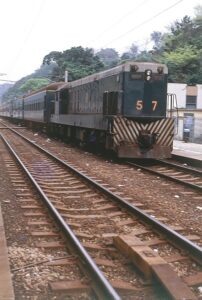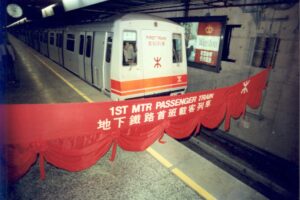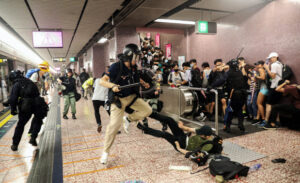Hong Kong is a sprawling metropolis with over 7.3 million individuals situated in a combined area of less than London and where land is scarce with 90% of its territory covered by mountains. Despite the challenges it faced with the population explosion after the Second World War, today Hong Kong is regarded as a city with one of the best transport systems in the world due to its punctuality and affordability, even gaining the title of having the best transport in the world.1 For this article, I will be focusing on the Mass Transit Railway or MTR which is arguably the backbone of Hong Kong’s efficient transport system. I will first analyse its beginnings, then followed by its association with the Hong Kong identity, and then analyse the negative association with higher living costs and being complicit with the Hong Kong government’s crackdown on civil liberties during the 2019 Anti-Extradition protests.
Prior to the construction of the MTR, there was only the Kowloon-Canton Railway (KCR) that opened in 1910, running a single-track line from Kowloon station in today’s Tsim Sha Tsui, through the then-rural areas of the New Territories and eventually crossing the border into mainland China through the Shum Chun river (today’s Shenzhen.2 Therefore, not many trains were needed and a single-line track to China sufficed as many individuals looking to flee the mainland from Communist persecution made use of the railway to reach the haven of Hong Kong.
However, the influx of population to nearly 4 million in 1970 and the overcrowding of urban areas and buses in Hong Kong and Kowloon proved to be unmanageable for the Hong Kong government and a new approach was needed. To complement the development of New Towns in the New Territories spearheaded by then-Governor General Barron Murray MacLehose, not only will the existing KCR line be double-tracked and electrified, a brand-new underground system initially running from the densely-populated housing districts of East Kowloon to the economic hub of Tsim Sha Tsui and eventually crossing the harbour into Central was constructed from 1975 and completed in 1979, completely transforming the way Hong Kong residents commuted.3 In particular, my family benefitted from the MTR construction as their daily commuting lives shortened from over an hour on buses to a mere half an hour by train from Kowloon to Hong Kong Island.

Figure 1: A diesel hauled train of the Kowloon-Canton Railway pre-electrification (circa 1960s colourised)

Figure 2: The first MTR train to ever run (Source: South China Morning Post)
The MTR has completely revolutionised people’s lives. According to a 2005 article by Man Hui Po a Hong Kong newspaper, it has become a pillar of the majority of Hong Kongers’ lives no matter which district they live in as since 1979 to the present day, the MTR has expanded to cover every district and its dominance over Hong Kong cannot be underestimated.4 The affordability and timeliness of the MTR is what makes it attractive. Even in non-peak hours, people can expect a train to arrive every 5 minutes unless it is the train lines for the less crowded districts. I have taken the MTR for granted as I have relied on it for my everyday commute to school since primary school all the way until my matriculation at St Andrews. I miss the jingle of trains, station announcements and people going on their daily lives for myself these sounds characterise the identity of Hong Kong. Although there are always people misbehaving on trains like playing music loudly, shouting obscene words or not covering your mouth when coughing, it is the MTR that makes Hong Kong function as without it, the idea of ‘Hong Kong efficiency’ will not be born as Hong Kong is known for being a city that never sleeps with individuals always rushing about to complete as much tasks as possible.5
Despite all the positive associations of the MTR, it has not been without its problems. For instance, after the merger of the MTR and KCR in 2007 in which the KCR systems have become under the operation of the MTR, it has become the sole monopoly of rail service provider of Hong Kong, hence limiting competition.6 The merger has also become a source of frustration among the local populace as it was rumoured that the MTR cooperation has been neglecting maintenance due to the increasing number of accidents that partially paralysed commuters, generating inconveniences among the commuters. Besides this, the MTR cooperation has also been portrayed as being complicit in the ‘Sinicisation’ of Hong Kong culture as not only does it have control over vast swaths of property and malls located close to stations with land prices being one of the most unaffordable on the planet. The discontent with the system came to a boiling point in the 2019 anti-extradition bill protests in which protesters initially calling for a controversial law allowing fugitives to be extradited to Mainland China for trail became a protest for free speech and democracy as the Hong Kong leader did not make concessions.7) The MTR has been criticised by the pro-democracy camp for assisting police officers by allowing them access to paid areas of stations to make arbitrary arrests and close stations where demonstrators gathered, as the police have been under fire for using excessive brute force against demonstrators.8
As a result, what was once Hong Kong’s pride can lose its prestige among its citizens within a short time as even places of mobility can become very politicised in the era of the digital world. Therefore, the MTR, although an inseperable part of Hong Kong’s identity and life can also be subject to criticism especially in recent years which society has become politicised.

Figure 3: Police cracking down on demonstraters at Prince Edward station on 31st July 2019. Source: Mainichi Shinbun
- https://www.weforum.org/agenda/2023/01/davos23-how-to-keep-cities-moving-sustainably/ [↩]
- John M. Carroll, A Concise History of Hong Kong (2006), p. 171). Up until the late 1960s, the northern areas of Hong Kong Island and most of Kowloon remained the core areas of Hong Kong with most of the business activities and industrial production centered around these two parts. In contrast, the New Territories remained a world of its own mainly focusing on agricultural production and village life. ((Frank Welsh, A History of Hong Kong (1997) [↩]
- Frank Welsh, A History of Hong kong (1997) [↩]
- http://paper.wenweipo.com/2005/03/12/NS0503120002.htm [↩]
- https://doi.org/10.1016/j.retrec.2021.101133 [↩]
- 港鐵,邁進新紀元,2007版 [↩]
- Michael C. Davis, Making Hong Kong China (2019 [↩]
- https://apnews.com/article/d4b799db57e54f42962b92dbebc57333 [↩]